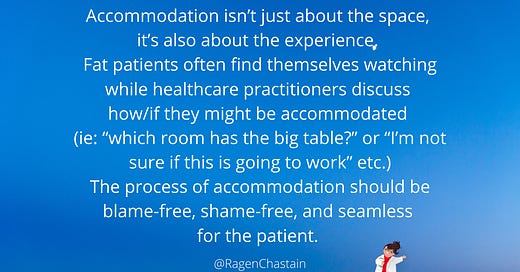This is the Weight and Healthcare newsletter. If you like what you are reading, please consider subscribing and/or sharing! You can also gift a subscription to a friend, family member, even a healthcare practitioner!
Over the years of working with healthcare practices, I’ve developed an informal audit for practices to use to become more fat*-friendly. Note that while this audit is specifically about size inclusivity, it is important to do similar work around inclusivity of people with other marginalized identities and those with intersecting marginalized identities.
We’ll start with the questions. The first is a list of questions to answer, the second is a process for an ongoing self-audit. Then I’ll discuss options for any areas where accommodation currently falls short.
I want to point out that this is not about fault or blame, it’s about solving the lack of accommodation (as much and as soon as possible, understanding that various things will be within and outside of individual control) so that a health practice supports people of all sizes.
I also want to acknowledge that this is not an exhaustive list, but rather a place to start, please share other ideas in the comments!
Audit Questions
Are all doors wide enough to fit an extra-wide wheelchair/walker/scooter?
Are there armless chairs/love seats in the waiting area and in each of the exam rooms (including for family members/advocates)?
Is there positive representation of people of size in office art, magazines, etc.
Are the reading materials in the office free from weight stigma and diet culture?
Do hallways and treatment rooms have ample space for accommodating and maneuvering of larger bodies and extra-wide wheelchairs/walkers/scooters?
Do you have practitioners and staff who are higher weight people?
If your practice performs weigh-ins, does the scale accommodate higher weight patients (minimum of 500lbs, preferably higher)?
Ideally, do you not require weigh-in unless it’s medically necessary?
If you do regular weigh-ins, is everyone in the practice clear about patients’ right to refuse weigh-in for non-medically necessary reasons? Is that right clearly communicated to patients (verbally, with signage etc.)
Are there protocols for medically necessary weigh-ins in which the patient is not informed of the weight (standing facing away from the scale, number not recorded into chart etc.)
Do you have extra-large adult/troncoconical/thigh cuffs for taking blood pressure?
Are there protocols for what to do when a properly sized blood pressure cuff is not available (ie: take pressure on forearm etc.) so that practitioners aren’t using too-small cuffs on higher weight patients and getting incorrect results?
Is everyone aware of where these cuffs are, and what the protocols are?
Do you have gowns in the largest possible sizes?
Does everyone know where those gowns are located? Are they easily accessed?
Are all exam tables and chairs high-weight rated (minimum of 500lbs, preferably higher)? Are a those tables and chairs also adjustable?
Is everyone in the practice aware of weight/size restrictions for any common diagnostic tools and tests the practice performs or refers patients to (ie: MRI, CT, ultrasounds etc.)?
Do you have a referral list that gives the options for higher weight patients (ie: wide bore MRIs)?
Do you know alternatives/options for any test that might not be able to accommodate your patient?
Is everyone in the practice aware of these?
Ongoing Self-Audit
Have staff and practitioners work to notice any situation in which a higher weight patient is treated differently than a thin patient.
For example, if the proper blood pressure cuffs or gowns are easily accessible for thinner patients, but must be searched for when working with higher weight patients, or if thinner patients get a gown but higher weight patients are asked to wear two gowns or given a sheet etc.
Keep a list and work together with admin staff/procurement to solve inequalities whenever possible, and develop non-shaming protocols for any cases where equality cannot be immediately reached.
X-Rays, CTs, MRIs and other Imaging
For imaging in higher-weight patients, please see this piece for detailed information.
What if the practice isn’t able to accommodate?
The goal here should be complete accommodation - so that we’re not creating spaces that only support the health of some people. Where that isn’t possible (at least immediately) you still have options. You can find them in this piece!
Did you find this post helpful? You can subscribe for free to get future posts delivered direct to your inbox, or choose a paid subscription to support the newsletter and get special benefits! Click the Subscribe button for details:
More Research
For a full bank of research, check out https://haeshealthsheets.com/resources/
*Note on language: I use “fat” as a neutral descriptor as used by the fat activist community, I use “ob*se” and “overw*ight” to acknowledge that these are terms that were created to medicalize and pathologize fat bodies, with roots in racism and specifically anti-Blackness. Please read Sabrina Strings: Fearing the Black Body – the Racial Origins of Fat Phobia and Da’Shaun Harrisons Belly of the Beast: The Politics of Anti-Fatness as Anti-Blackness for more on this.




Hi, and thank you for your work!
I live in France, where health at every size is still mainly considered as a way to encourage people to stay at high weight... You know what I mean, France is THE country of beautiful and model sized women (irony)!
As my doctor doesn't know where to refer me for any diagnostic center or practitionner, I have to find out myself, and also, to find out if it is inclusive or not, whatever marginalized identity considered...once there, so too late.
I would like to find out someone like you in my country, and work together to change things.
Would a magazine on food and or nutrition be considered "diet culture" and why?